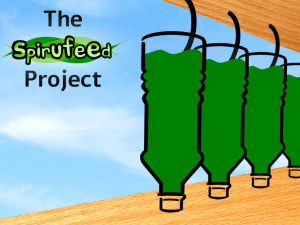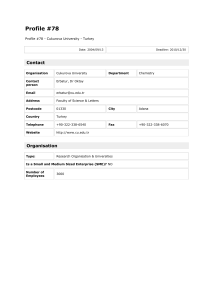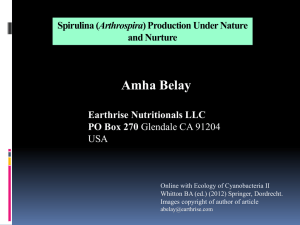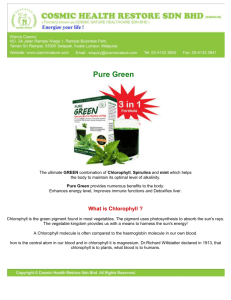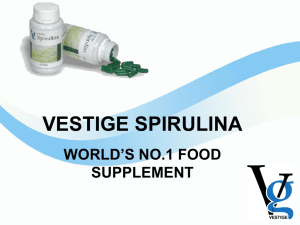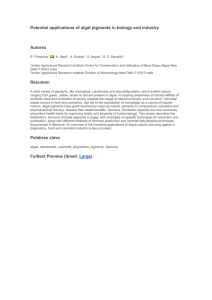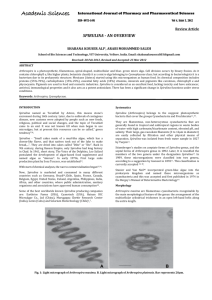Lessons from spirulina and noni
advertisement
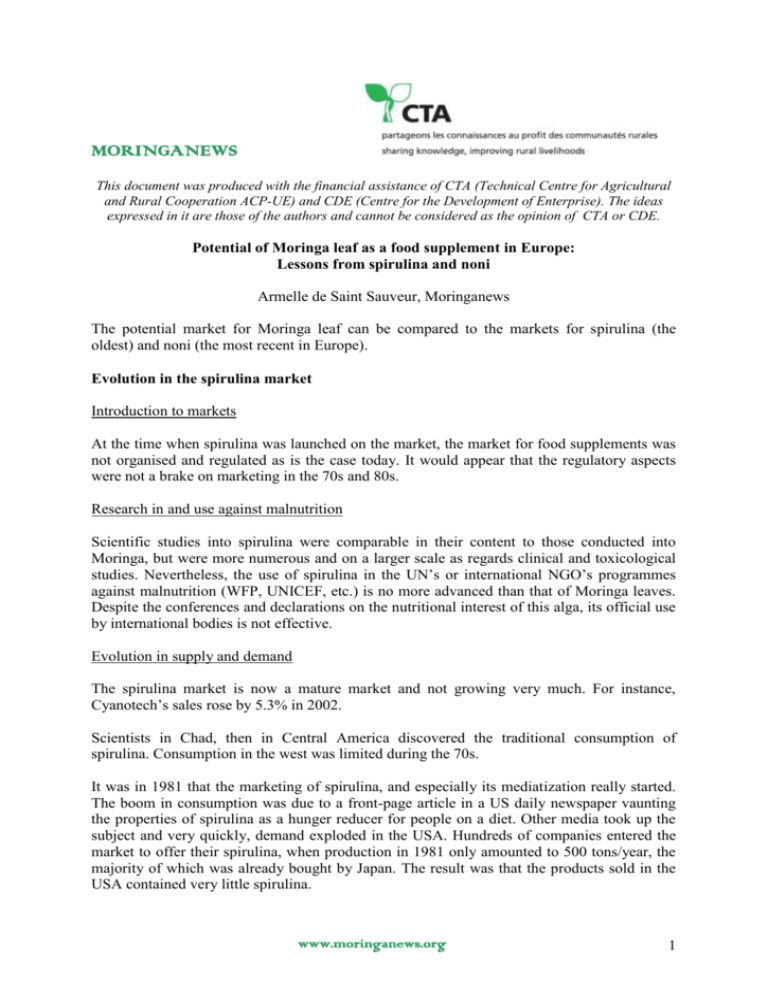
MORINGANEWS This document was produced with the financial assistance of CTA (Technical Centre for Agricultural and Rural Cooperation ACP-UE) and CDE (Centre for the Development of Enterprise). The ideas expressed in it are those of the authors and cannot be considered as the opinion of CTA or CDE. Potential of Moringa leaf as a food supplement in Europe: Lessons from spirulina and noni Armelle de Saint Sauveur, Moringanews The potential market for Moringa leaf can be compared to the markets for spirulina (the oldest) and noni (the most recent in Europe). Evolution in the spirulina market Introduction to markets At the time when spirulina was launched on the market, the market for food supplements was not organised and regulated as is the case today. It would appear that the regulatory aspects were not a brake on marketing in the 70s and 80s. Research in and use against malnutrition Scientific studies into spirulina were comparable in their content to those conducted into Moringa, but were more numerous and on a larger scale as regards clinical and toxicological studies. Nevertheless, the use of spirulina in the UN’s or international NGO’s programmes against malnutrition (WFP, UNICEF, etc.) is no more advanced than that of Moringa leaves. Despite the conferences and declarations on the nutritional interest of this alga, its official use by international bodies is not effective. Evolution in supply and demand The spirulina market is now a mature market and not growing very much. For instance, Cyanotech’s sales rose by 5.3% in 2002. Scientists in Chad, then in Central America discovered the traditional consumption of spirulina. Consumption in the west was limited during the 70s. It was in 1981 that the marketing of spirulina, and especially its mediatization really started. The boom in consumption was due to a front-page article in a US daily newspaper vaunting the properties of spirulina as a hunger reducer for people on a diet. Other media took up the subject and very quickly, demand exploded in the USA. Hundreds of companies entered the market to offer their spirulina, when production in 1981 only amounted to 500 tons/year, the majority of which was already bought by Japan. The result was that the products sold in the USA contained very little spirulina. www.moringanews.org 1 Consumers gradually distanced themselves from the product, which was neither spirulina nor hunger-appeasing, and the image of spirulina suffered enormously until 1986. American production in California and Hawaii, however, developed with two very large farms producing high quality spirulina. These farms, set up in 1982 and 1984, were producing more than one hundred tons each at the beginning of the 90s. At the end of the 80s, spirulina returned to the market with a new image, that of “green superfood” like chlorella and green barley or wheat sprouts, sold for their beneficial effect on health. The market for these products surged in the 90s in the USA, and it is currently developing in Europe. In the 90s, spirulina started to be sold in forms combined with other foodstuffs: with herbs, minerals and vitamins to promote physical performance, endurance, to reduce premenstrual stress, for its anti-oxidant effect, etc. Flavoured meal substitutes with spirulina were launched on the market, as well as pastes, bars and juice containing spirulina. At the end of the 90s, China and India flooded the market with spirulina, which pushed prices down and helped widen the public for the product. Nevertheless, the drop in prices often went hand in glove with a decline in quality: China especially started selling its surplus of poor quality spirulina in 1998. Although the quality was not the same, the other producers were forced to cut their prices. The average world price went from USD 18-20/kg in 2000 to USD 10-12/kg in 2002. China’s spirulina was selling for USD 8/kg in 2002. At present, companies that produce high-quality spirulina try to keep their market share by stressing the quality aspect, and at the same time, they are developing products with higher added value, extracting from spirulina components that they sell to other industries: food colouring, fluorescent markers, enzymes, etc. Genetically modified spirulina is also being developed, like spirulina with high iron, beta-carotene, zinc, etc. content. Case of Noni Noni juice has been marketed in the USA for ten years where it has scored a remarkable commercial success. It was for long prohibited for sale in Europe because of the beneficial effects to health claimed by the sellers of the product: effects on immunity, on the digestive system, on memory, physical performance, etc. The E.U. scientific committee on food considered that according to the documents presented, Noni juice does not have any additional advantages for health than other fruit juices. In the USA too, abusive advertising on the curative effects of Noni were sanctioned by several states that threatened the main producing company with legal action. The company preferred to settle by paying a fine of several million dollars and ending such practices. The product is now marketed as a simple health drink and the company sold over 400 million dollars worth in 2002. Noni juice was finally authorised in the E.U. in November 2003, without functional allegations (i.e. without any mention of preventive or curative health effects). This first authorisation was granted to a large American firm which had the means to provide www.moringanews.org 2 documents on the safeness of the product (even if the product is not sold for its effects on health, you must prove that there is no danger to health). Since then, many companies have requested marketing permission by using the simplified procedure of equivalence with another product already on sale in the E.U., and several have been given permission. An association of producers, the Association of Noni Producers from the Pacific islands, was even given permission for all its members by presenting just one dossier. This association was helped in the process by the Center for Developpement of Entreprise (CDE). According to the person in charge of the dossier at the CDE, there is no point presenting a dossier with health allegations for a product the public already knows, like Noni, as consumers are aware of its qualities. In ten years, Noni has become one of the most popular food supplements in the USA, especially among the Hispanic, Asian and Latin American communities. The market is booming in Asia, particularly Japan where demand could reach that of the USA. China, Thailand and Taiwan are also promising markets. Transformed products are developing in the USA and Japan, such as Noni bars, Noni sweets, teas, yoghurts etc. Conclusion for Moringa The story of spirulina, which has almost fully completed its product cycle, and that of Noni, which has just entered the market under the same regulatory conditions as those that will be imposed upon Moringa, allow us to perceive the stages and risks that Moringa can expect as a food supplement on the world market: Mediatization Beware of abusive advertising, in terms of content (give rise to exaggerated hopes) and quantity (too much advertising in relation to the available supply). That can completely discredit the product and reduce demand. But it is mediatization that launches a product, it is necessary but it must be controlled: the ideal would be a press campaign launched by a company which can communicate genuine information and provide a reliable supply (quantity and quality). Regulatory aspects Highlighting the effects on health is risky from the statutory point of view: difficulty to obtain marketing permission with functional allegations, and risk of legal proceedings, even in the USA. It is easier to enter the European market once an equivalent product is already sold. It is the first company to penetrate the market that must provide the most documents. Competition Production techniques evolve with demand: we will soon see intensive mechanised farms, situated in China, India and perhaps in the southern states of the USA, in South America or Australia if the demand for Moringa leaves is high. Competition builds up fast, and production costs have to be trimmed. In general, it is the first on the market who make the highest margins because once the market matures, world prices decline. To counteract competition, it is worth considering transformed products and extraction of active constituents from the raw product (leaves). www.moringanews.org 3

